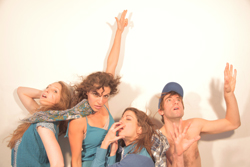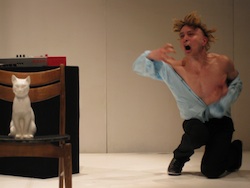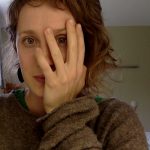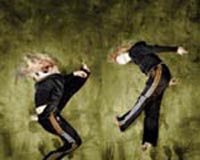It’s quite common to confront questions of engagement and resistance in performance. Bulgarian-born, Montréal-based Maria Kefirova’s new solo, The Nutcracker, addresses the interdisciplinary cross-fertilization of sound and movement, and the body’s readiness and capacity to absorb and deflect outside interference.
For this production at Tangente, the stage space is sparingly designed with three audio speakers, one centre stage; a large upright plank of plywood; a small plastic storage bin; a dangling pulley cord and two microphones placed on the floor. As Kefirova progresses through the hour-long work she explores an interactive audio environment. At first, there’s an insistent, filtered mechanical white noise filling the space, though it’s unclear where it’s emanating from because it sounds muffled. She’s barefoot, wearing an oversized purple knit “tuque” (as we say in Québec to describe a winter hat) and a coloured summer dress with a tropical motif, and she’s seated with her back to the audience. She rises, goes to the storage bin, opens the lid, and picks up a small recording device. Presto, sound mystery issue resolved. She presses the stop button. She then tucks the recorder into an inner breast pocket of her dress. The machine soon picks up the beat of her heart, which may be her “live” heartbeat, or else a looped recording. Kefirova opens and closes her mouth widely, and eventually shouts, “Enter! Entrez!”
Subsequent movements include her insistently knocking on the plywood as she repeatedly, rhythmically, jumps in place. Playback from the recorder captures the knocking as well as Kefirova’s breath, something that was not evident while she was jumping, and it permeates the space, via the speakers. She slips the recording device into her hat. Knocking loops persist. In another wonderful moment, she puts on red gloves, reminiscent of boxing gloves, takes each mic in hand, and with wide swooping movements captures the ambient sound. She speaks into the microphone, “Mic, mic.” The constant recorded repetition of her voice, and its various modulations, serves as a kind of “remembering” device or mechanism, as much, it appears, for the performer as it is for the viewer. It would seem that the audience’s exploratory perceptions are being coaxed into activity in the same way we’re watching the performer demarcate the space. In the mic section, for instance, I could feel myself connecting, at least internally, with what Kefirova was doing with her arms on stage. In essence, she is cannily affecting the physicality of the viewer.
Throughout the piece, Kefirova is constantly negotiating and physically shifting her direction, turning, focusing and refocusing her gaze. At one point she scrambles on all fours placing her head on the main speaker, as if plugging herself in. Each task has a calmness to it; it’s not relaxing, but it’s calm. Kefirova’s compelling cross-disciplinary performance and art practice reverberates with her research into affective complexities. She’s shaping the space and creating a kind of meditative zone. Within it the collection of sounds and audio elements she employs affects the movement, and shifts the mood and tone of the work.
When she declares, in an almost challenging tone, “Please don’t look at me,” while clearly in the audience’s line of vision, it is a request without an obvious response. My immediate question was “where should I look?” As if anticipating that reaction, she calmly says a moment or two later, “Look around me.” Of course, she is right. In shifting the audience’s focus she makes us see the space that she occupies and the dimension around her.
The scale and magnitude of the performance expands and increases by the end of the piece when Kefirova starts cracking nuts. We initially see her carefully placing handfuls of nuts picked from a bucket placed on the stage. The patterning is pleasing — for instance, we see her set some nuts down alongside her foot or the length of her arm. For a few moments, everything is quite contained, and the walnuts resemble constellations. But soon she picks up her pace, moving through the space, setting the nuts down quickly and randomly. Once she begins to smash the shells, mainly with her stiletto heels, the stage suddenly becomes a landscape of debris. The ferocity with which she attacks those little walnuts is amusing at first, because she seems to be in Terminator mode; but ultimately it’s a darker and more visceral experience because she seems possessed in her mission to destroy every single morsel. In applying pressure to crack the nuts, Kefirova experiences resistance. So she adapts and responds with force, raising further questions about balance and the control of body and muscle function.
Of course, by the end of attack, what we have come to know as one thing has been completely obliterated to reveal another. As the stage fades to darkness, she pulls out a flashlight to ferret out the few remaining walnuts still in their casings and smash them. She scoops up the debris and buries one of the speakers under a mound of shells.
Kefirova’s achievement in The Nutcracker is not only the discovery of the walnut’s outer core and inner meat — it represents, on a poetic level, the cracks and fault lines that can exist within the body. Resonance is explored as a physical, bodily surface that responds to external vibrations and sounds as well as its own frequencies. The stimulation that Kefirova exposes in this challenging work is individual, powerful, subtle and personal.
Tagged: Contemporary, Performance, Montréal , QC





